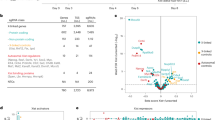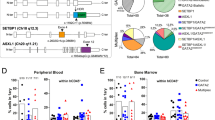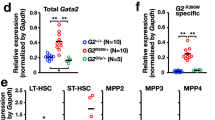Abstract
Members of the GATA protein family play important roles in lineage specification and transdifferentiation. Previous reports show that some members of the GATA protein family can also induce pluripotency in somatic cells by substituting for Oct4, a key pluripotency-associated factor. However, the mechanism linking lineage-specifying cues and the activation of pluripotency remains elusive. Here, we report that all GATA family members can substitute for Oct4 to induce pluripotency. We found that all members of the GATA family could inhibit the overrepresented ectodermal-lineage genes, which is consistent with previous reports indicating that a balance of different lineage-specifying forces is important for the restoration of pluripotency. A conserved zinc-finger DNA-binding domain in the C-terminus is critical for the GATA family to induce pluripotency. Using RNA-seq and ChIP-seq, we determined that the pluripotency-related gene Sall4 is a direct target of GATA family members during reprogramming and serves as a bridge linking the lineage-specifying GATA family to the pluripotency circuit. Thus, the GATA family is the first protein family of which all members can function as inducers of the reprogramming process and can substitute for Oct4. Our results suggest that the role of GATA family in reprogramming has been underestimated and that the GATA family may serve as an important mediator of cell fate conversion.
Similar content being viewed by others
Log in or create a free account to read this content
Gain free access to this article, as well as selected content from this journal and more on nature.com
or
Accession codes
References
Apostolou E, Hochedlinger K . Chromatin dynamics during cellular reprogramming. Nature 2013; 502:462–471.
Takahashi K, Yamanaka S . Induction of pluripotent stem cells from mouse embryonic and adult fibroblast cultures by defined factors. Cell 2006; 126:663–676.
Takahashi K, Tanabe K, Ohnuki M, et al. Induction of pluripotent stem cells from adult human fibroblasts by defined factors. Cell 2007; 131:861–872.
Yu J, Vodyanik MA, Smuga-Otto K, et al. Induced pluripotent stem cell lines derived from human somatic cells. Science 2007; 318:1917–1920.
Shu J, Wu C, Wu Y, et al. Induction of pluripotency in mouse somatic cells with lineage specifiers. Cell 2013; 153:963–975.
Montserrat N, Nivet E, Sancho-Martinez I, et al. Reprogramming of human fibroblasts to pluripotency with lineage specifiers. Cell Stem Cell 2013; 13:341–350.
Loh KM, Lim B . A precarious balance: pluripotency factors as lineage specifiers. Cell Stem Cell 2011; 8:363–369.
Patient RK, McGhee JD . The GATA family (vertebrates and invertebrates). Curr Opin Genet Dev 2002; 12:416–422.
Chlon TM, Crispino JD . Combinatorial regulation of tissue specificationregulation of tissue specification by GATA and FOG factors. Development 2012; 139:3905–3916.
Weiss MJ, Orkin SH . GATA transcription factors — key regulators of hematopoiesis. Exp Hematol 1995; 23:99–107.
Molkentin JD . The zinc finger-containing transcription factors GATA-4, -5, and -6. Ubiquitously expressed regulators of tissue-specific gene expression. J Biol Chem 2000; 275:38949–38952.
Ieda M, Fu JD, Delgado-Olguin P, et al. Direct reprogramming of fibroblasts into functional cardiomyocytes by defined factors. Cell 2010; 142:375–386.
Sekiya S, Suzuki A . Direct conversion of mouse fibroblasts to hepatocyte-like cells by defined factors. Nature 2011; 475:390–393.
Nakagawa M, Koyanagi M, Tanabe K, et al. Generation of induced pluripotent stem cells without Myc from mouse and human fibroblasts. Nat Biotechnol 2008; 26:101–106.
Xue Z, Huang K, Cai C, et al. Genetic programs in human and mouse early embryos revealed by single-cell RNA sequencing. Nature 2013; 500:593–597.
Chen Y, Bates DL, Dey R, et al. DNA binding by GATA transcription factor suggests mechanisms of DNA looping and long-range gene regulation. Cell Rep 2012; 2:1197–1206.
Wernig M, Lengner CJ, Hanna J, et al. A drug-inducible transgenic system for direct reprogramming of multiple somatic cell types. Nat Biotechnol 2008; 26:916–924.
Tsubooka N, Ichisaka T, Okita K, Takahashi K, Nakagawa M, Yamanaka S . Roles of Sall4 in the generation of pluripotent stem cells from blastocysts and fibroblasts. Genes Cells 2009; 14:683–694.
Lim CY, Tam WL, Zhang J, et al. Sall4 regulates distinct transcription circuitries in different blastocyst-derived stem cell lineages. Cell Stem Cell 2008; 3:543–554.
Buganim Y, Faddah DA, Cheng AW, et al. Single-cell expression analyses during cellular reprogramming reveal an early stochastic and a late hierarchic phase. Cell 2012; 150:1209–1222.
Neff AW, King MW, Mescher AL . Dedifferentiation and the role of sall4 in reprogramming and patterning during amphibian limb regeneration. Dev Dyn 2011; 240:979–989.
Zhang J, Tam WL, Tong GQ, et al. Sall4 modulates embryonic stem cell pluripotency and early embryonic development by the transcriptional regulation of Pou5f1. Nat Cell Biol 2006; 8:1114–1123.
van den Berg DL, Snoek T, Mullin NP, et al. An Oct4-centered protein interaction network in embryonic stem cells. Cell Stem Cell 2010; 6:369–381.
Pardo M, Lang B, Yu L, et al. An expanded Oct4 interaction network: implications for stem cell biology, development, and disease. Cell Stem Cell 2010; 6:382–395.
Elling U, Klasen C, Eisenberger T, Anlag K, Treier M . Murine inner cell mass-derived lineages depend on Sall4 function. Proc Natl Acad Sci USA 2006; 103:16319–16324.
Oikawa T, Kamiya A, Kakinuma S, et al. Sall4 regulates cell fate decision in fetal hepatic stem/progenitor cells. Gastroenterology 2009; 136:1000–1011.
Paik EJ, Mahony S, White RM, et al. A Cdx4-Sall4 regulatory module controls the transition from mesoderm formation to embryonic hematopoiesis. Stem Cell Reports 2013; 1:425–436.
Shu J, Deng H . Lineage specifiers: new players in the induction of pluripotency. Genomics Proteomics Bioinformatics 2013; 11:259–263.
Ben-David U, Nissenbaum J, Benvenisty N . New balance in pluripotency: reprogramming with lineage specifiers. Cell 2013; 153:939–940.
Zaret KS, Carroll JS . Pioneer transcription factors: establishing competence for gene expression. Genes Dev 2011; 25:2227–2241.
Trapnell C, Pachter L, Salzberg SL . TopHat: discovering splice junctions with RNA-Seq. Bioinformatics 2009; 25:1105–1111.
Trapnell C, Williams BA, Pertea G, et al. Transcript assembly and quantification by RNA-Seq reveals unannotated transcripts and isoform switching during cell differentiation. Nat Biotechnol 2010; 28:511–515.
Trapnell C, Roberts A, Goff L, et al. Differential gene and transcript expression analysis of RNA-seq experiments with TopHat and Cufflinks. Nat Protoc 2012; 7:562–578.
Gentleman RC, Carey VJ, Bates DM, et al. Bioconductor: open software development for computational biology and bioinformatics. Genome Biol 2004; 5:1–16.
Feng J, Liu T, Qin B, Zhang Y, Liu XS . Identifying ChIP-seq enrichment using MACS. Nat Protoc 2012; 7:1728–1740.
Robinson JT, Thorvaldsdóttir H, Winckler W, et al. Integrative genomics viewer. Nat Biotechnol 2011; 29:24–26.
Bailey TL, Boden M, Buske FA, et al. MEME SUITE: tools for motif discovery and searching. Nucleic Acids Res 2009; 37:W202–W208.
Salmon-Divon M, Dvinge H, Tammoja K, Bertone P . PeakAnalyzer: Genome-wide annotation of chromatin binding and modification loci. BMC Bioinformatics 2010; 11:415.
Zheng L, Baumann U, Reymond JL . An efficient one-step site-directed and site-saturation mutagenesis protocol. Nucleic Acids Res 2004; 32:e115.
Acknowledgements
We thank Yang Zhao and Jun Xu for helpful discussions. This work was supported by the National Basic Research Program of China (973 Program; 2012CB966401), the National Natural Science Foundation of China (91319305), the National Science and Technology Major Project (2013ZX10001003), the Ministry of Science and Technology of China (2013DFG30680) and the Ministry of Education of China (111 Project) to HD, and the Strategic Priority Research Program of the Chinese Academy of Sciences (XDA01040407), the National Natural Science Foundation of China (91019024 and 31100558) and the Hundred Talents Program of the Chinese Academy of Sciences to YS.
Author information
Authors and Affiliations
Corresponding authors
Additional information
( Supplementary information is linked to the online version of the paper on the Cell Research website.)
Supplementary information
Supplementary information, Figure S1
Characterization of GATA-reprogrammed iPSCs. (PDF 6915 kb)
Supplementary information, Figure S2
Quantitative RT-PCR analysis of the expression of endogenous ECT related genes relative to the expression of SKM. (PDF 933 kb)
Supplementary information, Figure S3
A schematic diagram to illustrate zinc-finger domains in GATA family members. (PDF 386 kb)
Supplementary information, Figure S4
Strategies for mutation of GATA family members. (PDF 8061 kb)
Supplementary information, Figure S5
Quantitative RT-PCR analysis of the expression of endogenous Dlx3 and Lhx5 genes relative to the expression in SKM, G1D, G2D, G3D, G4D, G5D, and G6D represent corresponding GATA-Double mutations. (PDF 1166 kb)
Supplementary information, Figure S6
Venn diagram illustrating the overlap genes during secondary MEFs reprogramming. (PDF 1606 kb)
Supplementary information, Figure S7
Sall4 substitutes for Oct4 in MEF reprogramming to pluripotency. (PDF 3078 kb)
Supplementary information, Figure S8
ChIP-seq binding profiles for Sox2 and Nanog loci using secondary MEFs. (PDF 1800 kb)
Supplementary information, Figure S9
Western blot analysis of SALL4 knockdown in different GATA family member-mediated secondary MEF reprogramming. (PDF 1332 kb)
Supplementary information, Table S1
Number of reads (total reads, mapped reads, unique reads) in RNA-seq (GATA4) (PDF 4719 kb)
Supplementary information, Table S2
Distribution of all expressed genes in different expression levels (GATA4) (PDF 2268 kb)
Supplementary information, Table S3
Number of reads (total reads, mapped reads, unique reads) in RNA-seq (GATA6) (PDF 5183 kb)
Supplementary information, Table S4
Distribution of all expressed genes in different expression levels (GATA6) (PDF 2451 kb)
Supplementary information, Table S5
Number of reads (total reads, mapped reads, unique reads) in ChIP-seq (PDF 4465 kb)
Rights and permissions
About this article
Cite this article
Shu, J., Zhang, K., Zhang, M. et al. GATA family members as inducers for cellular reprogramming to pluripotency. Cell Res 25, 169–180 (2015). https://doi.org/10.1038/cr.2015.6
Received:
Revised:
Accepted:
Published:
Issue date:
DOI: https://doi.org/10.1038/cr.2015.6
Keywords
This article is cited by
-
GATA4 Is a Transcriptional Regulator of SOX2 in Japanese Flounder (Paralichthys olivaceus)
Journal of Ocean University of China (2022)
-
Advances in RNA Viral Vector Technology to Reprogram Somatic Cells: The Paramyxovirus Wave
Molecular Diagnosis & Therapy (2022)
-
Permissive epigenomes endow reprogramming competence to transcriptional regulators
Nature Chemical Biology (2021)
-
Biological importance of OCT transcription factors in reprogramming and development
Experimental & Molecular Medicine (2021)
-
An Insight into Reprogramming Barriers to iPSC Generation
Stem Cell Reviews and Reports (2020)



